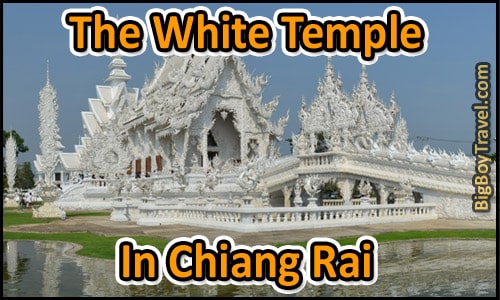The White Temple in Chiang Rai:
Official Name: Wat Rong Khun
Getting Here: From Chiang Rai by taxi and Chiang Mai with a group tour.
Cost: Free (Donations go to the ongoing construction costs)
Temple Hours: Daily from 6:30am-6pm.
Art Gallery Hours: Daily 8am-5:30pm
They say that you haven’t truly arrived in Chiang Rai until you visit the amazing White Temple (Wat Rong Khun). This intricate Temple is a sea of whitewashed surfaces and mirrors chards worked into a living museum of contemporary artwork. It is one of the most beautiful Buddhist Temples we have ever been to and is by far the most whimsical. With its beauty, it is no wonder that tourists from around the World have made Chiang Rai’s White Temple one of the most visited attractions in Northern Thailand.
Overview of the White Temple:
While most major temples in Thailand are 100s of years, construction on the elaborate White Temple didn’t start until 1997. The man behind the Temple is famed Thai artist Ajarn Chalermchai Kositpipat who wanted to make a modern Temple honoring Buddhism through his contemporary style. He bought a 3-acre lot, which already had a much older Temple on it, and quickly transformed it into a 9-acre complex. When fully completed he will have a total of 9 buildings, but it is still supposed to take over 100 years to finish. Ajarn currently has a crew of workers and a direct understudy, but wants to have two consecutive classes of students working on the complex as he believes it may take up to 90 years after his death to finish. When the White Temple is finally complete it will show one man’s dedication to his religion and his country.
As you enter grounds of Wat Rong Khun the contemporary elements are striking. From parking cones capped with skulls, to creatures from the movie Predator climbing out of the ground, you’ll be busy snapping photos left and right. Between photos make sure to take in the great message and symbolism of the White Temple. Playful signage warns you about the temptations of smoking or drinking while hanging shrunken heads show you people that have given in too often.
Entering the central Temple you’ll find a whitewashed area showing purity and tons of mirror bits reflecting the wisdom of Buddha. Our favorite part of the central Temple is the white bridge that leads the way. You’ll pass over a field of hands all trying to full you off your course with temptations, you’re greeted by powerful guardians, and will metaphorically transcend up to heaven as the bridge gets higher and higher. Once inside the main prayer chamber, a number of colorful murals full of pop culture references are full of even more hidden symbolism (explained below). As you exit the central temple make sure to take some time to visit the other buildings of the complex before leaving.
Murals Inside the White Temple:
On the back wall of the central Temple is a beautiful mural showing Buddha struggling and fighting with the demon Mara. This image of Mara represents Buddha battling his own demons before he obtained enlightenment and freedom from immoral thoughts through meditation. In front of the mural is a multi-tiered statue of Buddha starting as a man and later sitting at the edge of the universe after working to the state of full Nirvana. Ajarn wanted visitors to feel the peace, happiness, and kindness of Buddha to all beings.
Our favorite mural in the central Temple is the very modern one just on the inside of the front entrance. It’s hard to even describe this mural and all of its pop culture references in words as there are so many. You’ll see comic book style illustrations of Superman, Neo from the Matrix, images from Star Wars, and more. The collection of heroic figures may seem random but the artist did it on purpose to remind us that Super Heroes don’t exist in real life to save us and we need to push for a World of peace.
This same message of peace carries through with the controversial use of faint images of both American President George W Bush and Osama Bin Laden in each or the eyes of the mural’s large devil figure. The artist Ajarn meant to send a message of peace to both men the discourage the use of violence and weapons that kill. Nearby is also a moving image of New York’s Twin Towers burning with missiles shooting outward in retaliation. The point isn’t to be offensive, but instead to say that war and violence are never the answer even in retaliation. As you can tell Ajarn really believes strongly in the message of peace both inner and Worldly at all costs and isn’t afraid to express it in his art.
Architectural Symbolism At The White Temple:
The Color White: Ajarn felt he wanted something different from most Thai temples which are gold. He views the color gold as appealing only to people who lust after actual gold.
Use of Mirrors: Used as a symbol of the Wisdom (Dhama) of Buddha which shines throughout the Universe. The chards of mirror shine the most in the early morning or late afternoon when the sun is low.
Sea of Hands: As you approach the Temple a sea of hand reaches out at you in all sorts of motions representing the physical temptations that try to corrupt us.
Foot Bridge: Is meant to lead you past temptation and high up into the Temple which is Heaven.
Giant Tusks: The huge tusks on the sides of the bridge are the mouth of the devil representing the desires in mind.
Monsters On The Bridge: There are 8 monsters on each side of the bridge representing the 16 causes of sorrow.
Crest of the Bridge: The crest represents the legendary Mount Meru which in ancient Hindu was the Center of the Universe and was said to be 672,000 miles high.
Other Buildings At The White Temple:
There will be 9 total buildings when the complex is completed but that won’t be until sometime around the year 2100. The long building process is because it is extremely detailed and every part they complete needs to be fully cleaned 3 times a year. The fruits of the Ajarn’s groups are already showing as some of the secondary buildings are either started or completed. The most impressive is the Golden Toilet building which looks like a large golden temple. Ajarn went all out on the design and intends for the building to be the most beautiful bathroom that exists. Near the bathroom is a museum on the White Temple with a small Art Gallery displaying Ajarn recent works which are also for sale.
Probably our favorite thing outside of the central Temple is the small passport stamp station where you can and an awesome Wat Rong Khun to your passport proving you made it here. As you leave the passport stand on the way to a fish pond well, check out the large tree with metallic leaves. You may have noticed the leaves hanging decoratively throughout the White Temple grounds and you can help add to it. Each leaf was bought by a visitor who wrote their own prayer message on the back. Even if you aren’t Buddhist, buying a leaf and adding a message is a great way to leave your fingerprint on this magical temple complex.
About The White Temple’s Builder:
Ajarn Chalermchai Kositpipat was born small local village of Ban Rong Khun Born and grew up without electricity. He witnessed a lot of violence growing up but fought through it to make it to art school. After practicing his various styles Ajarn found his groove and became a very successful artist. Before breaking ground on the White Temple Ajarn was doing 200 pieces of art a year, but has had to scale it down to around 10 a year. Today he dedicates almost every day of the year to work on the White Temple and badly wants to put Thai arts on the map.
Ajarn wants his style to be solely from his own vision free of outside influences so he doesn’t take donations from the government, politicians or millionaires. He also strives to be as free as he can be of being influenced solely of styles from other periods and tries to blaze a new path with his style. As part of giving back to the community, Ajarn also built the large Golden Clock in downtown Chiang Rai to replace the previous Kodak Clock. Ajarn felt the historic Kodak Clock didn’t fit the city’s personality and built the new one by donating his own time and money. The old clock has since been moved near Chiang Rai’s market.
Wat Rong Khun Visitor Guidelines:
There are no pets, food, drink, smoking, or umbrellas allowed on the temple grounds although there is a neighboring food court where you can eat and drink. You are also not allowed to have been drinking any alcohol before entering as it is an active Buddhist temple. Because it is an active temple, the standard dress code applies so you are discouraged from wearing shorts or leaving your shoulders uncovered. When entering the central temple abbot you will have to remove your shoes.
Unfortunately, because some foreign tourist have displayed inappropriate behavior at the Temple, all non-Buddhists visitors are supposed to be accompanied by a tour guide to enter.






